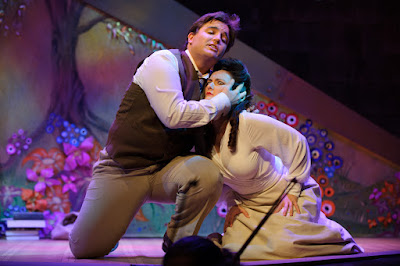With the knowhow to pep our sense of curiosity, you come to expect to be rewarded with the unexpected in Melbourne-based Chamber Made Opera's work. Their latest venture, Between 8 and 9, is a deeply collaborative partnership with China's Sichuan Conservatory of Music. The result is a banquet of meditative and otherworldly blending and churning of instrumental, vocal and electronic sound that powerfully distances the observer from routine and places them in an abstracted cross-cultural medium of sorts. Regardless of what you make of it, it's therapeutic, sometimes puzzling and entirely engaging.
 |
| Percussionist Wang Shuai, Between 8 and 9 |
So what exactly happens? The number eight, representing harmony and prosperity in Chinese numerology, dictates the format. Each audience member receives an envelope containing a coloured card that identifies a spot at one of eight round tables at which they can take a seat amongst seven others. Prominent is a rectangular lazy Susan featuring geometric workings and thin rods magnetically supported on the surface that looks sculpturally appealing and mathematically perplexing. Each of the eight performers are seated at a table. Lighting is subdued as the Salon of the Melbourne Recital Hall takes on the feel of a function room, or Chinese restaurant, in which the audience unites in communal conditioning. The serenity and energy is palpable.
Wang Zheng-Ting opens with the mellifluous piping of the sheng (a form of Chinese mouth organ) to expose what feels like a vast distant landscape. It's followed by a dance-like form before identifying a world that conjures a blend of Chinese and Australian motifs as each performance artist constructs a simple scene - a circle of green silk is placed down, a square wooden block and triangular prism form a simple dwelling, a silvery circle is planted with lotus leaves and three rods stand vertical with a disc atop as if emulating a windmill. The striking visual effect is accompanied by vocally produced mosquito sounds, claps to catch them and yawns that are, of course, catchy! As one of the most captivating segments, its construct cleverly both describes and blurs differences to establish harmony when cultures come together.
 |
| Sheng master Wang Zheng-Ting, Between 8 and 9 |
Halfway through its 70-minute duration, the artists serve buckwheat tea as a carnivalesque-like Klezmer-sounding music is played by Humphrey on trumpet, Connors on accordion with Wang joining on sheng. It relieves part of the intensity while cementing a sense of unity with many fellow attendees keen to let loose in conversation.
Sung and poetically spoken Chinese and English pepper the experience alongside a clarity and resonance of musical delivery with creative producer Tim Stitz and a team of collaborating creative artists' influence giving an all-encompassing and striking effect.
And what of nine? In Chamber Made Opera's artists' statement we learn that nine symbolises "achievement on a higher spiritual plane" and that the work "explores the space between the two". On that level, experiencing Between 8 and 9 succeeds. With no narrative, our focus is shifted, discoveries are made and the artistry speaks to us in both a personal and collective sense through cultural differences. It makes for a priceless experience.
BETWEEN 8 AND 9
Chamber Made Opera
Salon, Melbourne Recital Centre
Until 1st April
Production photos: Jeff Busby







